How to Set Up a Sales Funnel for your Handmade Business
This post may contain affiliate links, which means I’ll receive a commission if you purchase through my link, at no extra cost to you. Please read the full disclosure here.
In the past couple weeks there have been two products appear in my Facebook feed that have piqued my interest. One, I instantly purchased after visiting their website and the other, I didn’t even get close to putting in my shopping cart. One had a good sales funnel and the other had bad sales funnel.
Both products caught my attention and initially had me thinking I would buy, so a good start to two different sales funnels. But it all went downhill from there with the one company while the other one actually went uphill and encouraged me to buy more.
One product was a niche product: a water bottle that tracks how much water you drink and the other was a nice sweater.
The sweater was exactly my style, had a few colors I loved and cost less than the water bottle. But after clicking through the photos, reading the description and checking out the reviews, I decided it wasn’t a good idea to buy.
On the other hand, the water bottle’s website further increased my perceived value of it and after going over the details and discovering their promotion, I purchased not just one but two water bottles.
The sweater website felt cheap, so I expected the sweater would likely look and feel cheap as well. The photos were okay but there weren’t any detail or close-up pics, which raised another red flag. The description was average but then came the review section. It was a big hole in their funnel that a lot of potential customers escaped through.
Even though the price and shipping costs of the sweater were less than the water bottles, I didn’t want to take the risk of receiving something I didn’t feel good wearing, that would only last a few washes or might not even arrive in the mail. The photos and descriptions gave me a bit of doubt but the reviews confirmed them and encouraged me not to buy and not to even bother signing up for their newsletter.
A product listing will either:
- Make me think a product is perfect for me and I need it right away
- Convince me it’s a good choice and that I should seriously consider it
- Put doubt in my mind or prove it’s not the right fit
There’s not much you can do for those people your product just isn’t the right fit for but sales funnels will help you sell to more people your product is a fit for.
WHY YOU ABSOLUTELY NEED A SALES FUNNEL
No one sees a product for the first time and marches straight to the checkout. Whether online or in-store, we take the time to examine, even if we’re in love with it and 99% sure we want to purchase. Product tags, finishing details, descriptions, photos, sales pitches, reviews, etc. all must nudge a shopper closer to the checkout.
One wrong move and shoppers are heading in the other direction.
When someone lands on your website or shows up at your craft fair table, you must lead them through a process that strengthens their belief it’s a good idea to buy and eases them into it.
I like to call this a sales channel funnel; elements that are a part of your craft show display, website or online shop that encourage shoppers to place an item in their shopping cart.
You don’t jump in with a “Here’s my newest scarf. Ready to buy?” when a shopper first walks up to your table and you don’t leave a description blank or use the space to describe what a shopper has already gathered from the photo (Beautiful green knitted wool scarf). Neither of those approaches influence someone to buy.
But you can’t just have a sales channel funnel; you must also have a sales funnel for people who are interested in your product but aren’t ready to buy.
An average 2% of shoppers will purchase. That means 98% of the people you work so hard to get to your online store or attract to your craft show table, end up leaving without taking action.
NINETY-EIGHT PERCENT!!
So instead of giving shoppers two options:
- Buy
- Don’t buy
You add a third option that requires less commitment and allows you to stay in touch:
- Buy
- Don’t buy
- Subscribe to my newsletter
You know that people who visit your sales channel (website, online shop, craft show table, etc. more sales channels listed here) are interested in your products. Some people will decide your products aren’t the right fit (e.g. not what they’re looking for, live in an area you don’t ship to, not a fit for their budget, etc.) but the others who are still interested but don’t buy, are considered leads.
So you also need a sales funnel for leads, which helps them build confidence in your brand and the idea that buying is the right choice.
And once someone has purchased, you must continue to market to them.
It costs much less money to retain a customer than acquire a new one. Plus, repeat customers tend to spend more money, so it’s a win-win.
Instead of reaching someone on Facebook several times, encouraging them to visit your website, getting them into your sales funnel, sending emails and answering questions to get a sale, you’re able to send an email to an existing customer and be more likely to make a sale through just one step.
That’s why you need another sales funnel to keep sales rolling in from existing customers.
IN SUMMARY
STEP 1: The job of your sales channel’s funnel is to either get a shopper to buy or to be interested enough they’re willing to hear more about your product in the future.
STEP 2: Your lead sales funnel’s job will be to convert those interested shoppers into buyers.
STEP 3: And once someone becomes a customer, you need a funnel in place to encourage them to buy from you again.
All three steps are explained in detail in my new ebook HOW TO SELL HANDMADE BEYOND FRIENDS & FAMILY but I’m going to go over how to set up an automated lead sales funnel for your business in this article.
For each step (and for so many other reasons) you need to set up a newsletter and start gathering email addresses.
I understand that it can seem like an unnecessary monthly expense to start a newsletter but trust me; every business needs a newsletter!
I use a lead sales funnel for Made Urban and swear by Convertkit. This post does include affiliate links for them but I sing their praises even when I’m not making a commission 😉
I started collecting emails and sending newsletters through Mailchimp, which was a good platform, but now that I’ve been on Convertkit for almost a year, there’s no comparison for me; Convertkit is the best option.
Traffic to our website really started to ramp up about a year and a half ago but I didn’t see a big jump in my subscribers until I switch over to Convertkit in December of 2016. I’ve grown my subscribers by more than 4000% and it hasn’t even been a full year yet.
If you’ve joined my 5 DAYS TO A STANDOUT DISPLAY CHALLENGE, you’ve gone through one of my sales funnels.
I set it all up through Convertkit and have had amazing success with it.
In general, the conversion rates for my sales channels and newsletter signup forms, as well as the open rates and click rates for my newsletters are all well above average so I figure…I must know what I’m doing 😉
But…enough about me, let’s get to how you can set up a sales funnel for your handmade business’ leads.
HOW TO CREATE A SALES FUNNEL
The first step is awareness but we’re not going to go into detail here. Awareness involves using marketing channels and methods that grab people’s attention and direct them to one of your sales channels.
Facebook posts, showing up in Google searches, advertisements, setting up at a craft show, etc. are all ways to get your business in front of new people. I cover many more marketing channels and methods in HOW TO SELL BEYOND FRIENDS & FAMILY so check that out if you could use a little help with the first step of marketing.
Once you’ve gotten people to your sales channel, your first choice is to sell to them (covered in your sales channel funnel and explained in my ebook) and the next best option is to get them onto your newsletter list and into your lead sales funnel.
SALE FUNNEL STEP 1 – CREATE AN OPT-IN OFFER
Start with an incentive: why should people join your newsletter list?
Someone has made it to your website or listing page, they’re obviously interested in what you’re selling but they’re not invested yet.
What might be their objections?
If someone likes your product but decides I’m not sure if it’s right for me or I’ll think about it and maybe come back later to buy, consider what is it they’re unsure of or need to think about?
It may be:
- Price
- Cost of shipping
- Length of time to ship
- Not sure if they need it
- Unsure of how it will work for them
- Unanswered questions (e.g. what are the exact dimensions)
- Website design (e.g. too slow, not loading)
Some of the issues, such as slow loading website and unanswered questions, should be resolved right away and don’t require a sales funnel. But any other reasons you brainstorm that can be fixed through persuasion (e.g. showing shoppers why your products are worth the price), should be considered for the content of your sales channel.
For example, based on the reasons for not buying, your opt-in offers may be:
- Price – sign up for a promo code for a discount on their first purchase, entry into a contest or a free gift with purchase
- Cost of shipping – sign up for a promo code for free shipping
- Length of time to ship – sign up for a promo code to rush their order or upgrade their shipping for free
- Not sure if they need it – sign up for 5 ideas on how celebrities are wearing this look
- Unsure if the item will be a fit – sign up to try this item risk-free
The most common type of opt-in form offered by ecommerce stores is the discount offer (e.g. sign up and receive 10% off your first order).
This isn’t always a good idea for handmade businesses and should only be done if your margins can cover the discount. Meaning, even with giving customers a percentage off their order, free shipping, etc. you still make a healthy profit.
When you do run a sale or promotion (e.g. end of summer sale), instead of just slashing the prices on your listings, consider requiring a shopper to sign up for your newsletter to access the sale prices. It increases your chances of getting a return on investment since you get a chance to sell to that person again in the future. If you simply lower your prices, anyone can access the sale price and you don’t get the opportunity to keep in touch with them.
Although the discount offer is most popular, it’s not the only option. Not to mention, it’s not always the best. Many people who subscribe to get a deal tend to unsubscribe once they get the discount or promo code.
Consider what else might be a benefit to your shoppers. You really must have a clear idea of who your ideal customer is. The success of your entire sales funnel relies on you really knowing the niche market you’re selling to. Guess what?! My new ebook helps you with that too 😉
Let’s say you want to get into shape and you land on a website with a product or article that’s going to help you do that. A pop up appears offering something in exchange for you giving your email address.
Which offer piques your interest?
- How to lose 5 pounds in 10 minutes/day
- How to lose 10 pounds without exercise
- How to tone your butt and look great in a bikini next month
- How to flatten your tummy with this intense 4 week program
- 10 days to get toned arms at the gym
It depends on your goals and your workout preferences right? If you hate working out, option 2 will grab your attention. If you’re looking to flatten your tummy, it’s option 4.
If that website doesn’t know the details of their ideal customer, they’re likely to throw out an opt-in offer that doesn’t get subscribers.
Sure, your customers may wear jewelry (or scarves or handbags or hang art, etc.) but there are all kinds of people who wear jewelry. Are they someone who:
- Likes to stand out and make a statement
- Follows trends
- Never follows trends
- Is a trend-setter
- Loves a classic, pin-up or gothic style
- Loves a beachy, relaxed look or wants to appear very polished and put-together
Someone who follows trends may appreciate a jewelry trend report for the current season with ideas on how to wear the looks.
A few other opt-in ideas for handmade businesses to encourage shoppers to join their newsletter are:
- A video showing the steps for an at-home, glowing skin spa treatment (for bath & body products)
- 5 simple changes that make our world more animal-friendly (for cruelty-free products)
- Printable packing checklist & tips for pack jewelry to avoid damage (for jewelry products)
- 5 nursery color schemes that don’t involve pink or blue (for nursery décor items)
- 10 tips for buying art online and how to know if a piece is right for your home (for art)
The more you tailor the offer to your exact customer, the better chance you have getting them into your sales funnel.
Think about:
- How your customer might wear/use/display/consumer your product
- The type of lifestyle your ideal customer is likely to have (e.g. jet-setting, athletic, environmentally-friendly, etc.)
- How can you educate or inspire your customer
Informational offers are something you can put work into creating once and reap the benefits over and over, so the time in to get it right.
Another popular opt-in offer is to keep shoppers up to date on new arrivals, exclusive items, deals, contests, etc.
Brainstorm the objections people may have when it comes to buying your product or the interests that might appeal to them. Then come up with an opt-in offer.
SALES FUNNEL STEP 2 – CREATE A FORM
Convertkit allows you to create multiple forms to collect email addresses so you can alter the text, image, opt-in offer, etc. based on what your website visitors are viewing.
For example, a vendor selling art for a nursery may have the opt-in offer 5 nursery color schemes that don’t involve pink on product listings for female products and 5 nursery color schemes that don’t involve blue on product listings for males.
You not only need interesting opt-in offers but you also must find an interesting way to communicate them on your forms.
“Join my newsletter” won’t capture as many emails as a form that communicates the benefits of being a subscriber. Join your newsletter list and I get what out of it?
Join my newsletter to stay up to date on new product releases
Could turn into:
Don’t you hate it when you forget where you saw that awesome item? Join my newsletter for monthly reminders on where to find awesome items.
OR
Join my newsletter and be the first of your friends to know about new trends.
Find a way to add personality to your opt-in form and tell visitors the benefits of subscribing.
Create as many forms as you like on Convertkit using the FORMS tab and CREATE FORM button. Your graph will keep track of how many subscribers subscribe through each form and display through the different shades of blue within a bar. If you place your cursor on a block of the bar, it will show you which form that block represents and how many subscribers it collected that day.
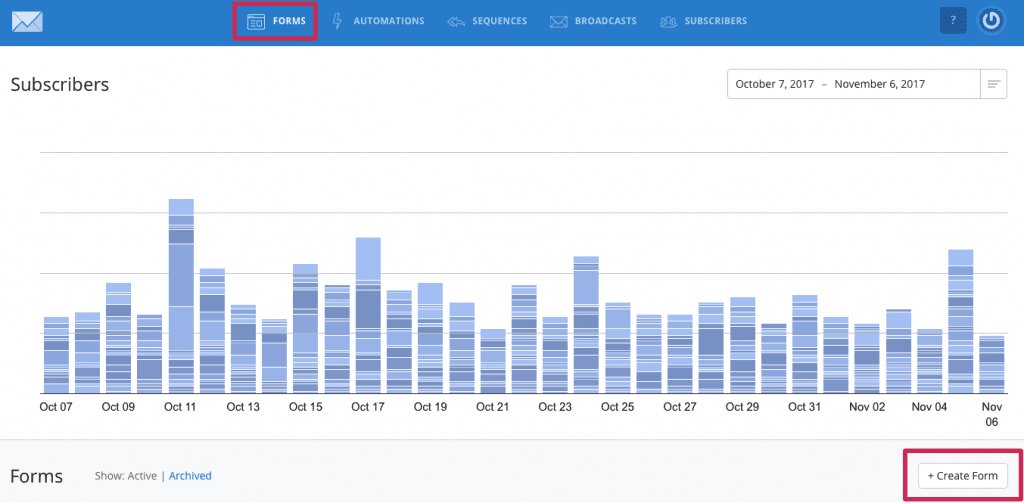
As you can see, I have many different forms as I like to know which pages of my website are converting the best, as well as offer different opt-ins based on the subject of the page.
You can choose to create a form (which appears on your website) or a landing page (which your website links to and is hosted by Convertkit).
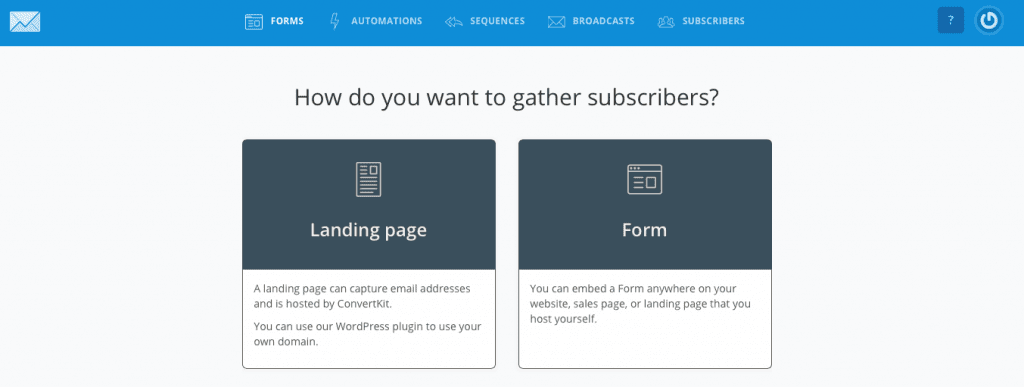
And you can choose between a few different styles of forms (I like the style on the left best)
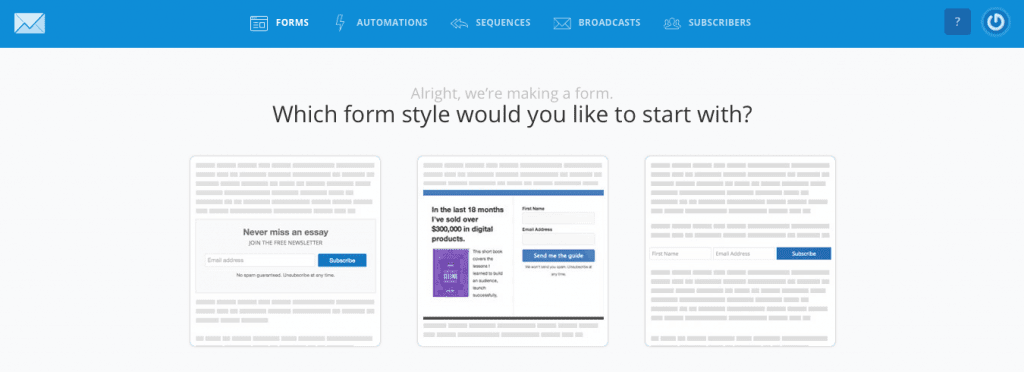
Once you set up the content of your form, you can go into SETTINGS to:
- Set the message subscribers see after they enter their email or send them to URL if you’ve set up a custom “thanks for subscribing” page on your website
- Subscribe them to a sequence (which will be your sales funnel, explained in the next step)
- Choose if you want double opt-in and the content of that confirmation email
- Set whether you want the form to appear on your page, as a pop up or as a slide in form
- Get the code for the form
- Much more
SALES FUNNEL STEP 3 – CREATE A SEQUENCE
Sequences allow you to set up a series of emails that are slowly sent to subscribers and designed to convince leads it’s a good idea to buy from you. Convertkit allows you to set up those emails once and automatically send them as new people subscribe.
You can choose:
- When you want to send each email
- Set day to 0 to send immediately after they sign up
- Set how many days or hours you want the next email to send after the prior email in your sequence
- Which days you’d like to send the emails on – if you tend to get lower open rates on Sundays, you can uncheck Sunday so an email from the sequence is never sent on that day

Add just a few emails to the sequence or several by using the ADD EMAIL button.
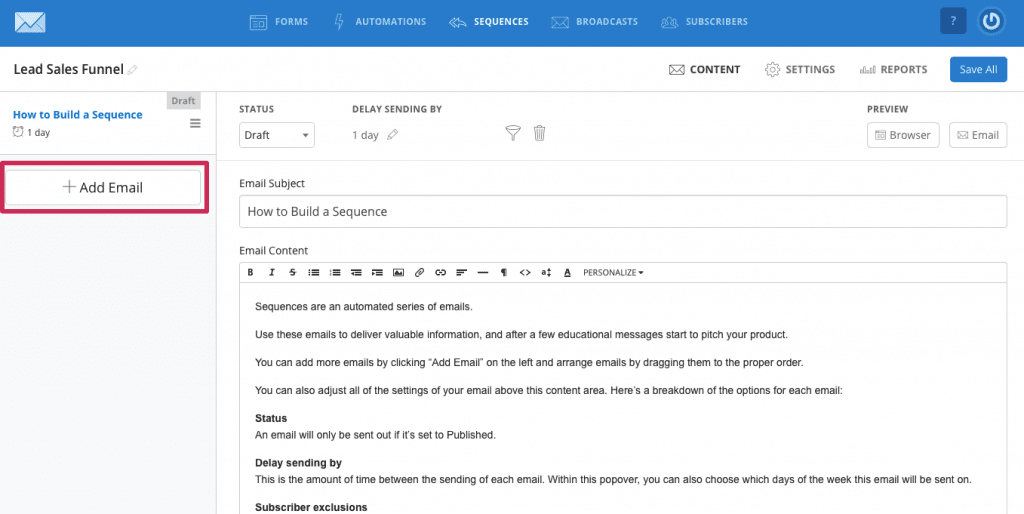
Let’s take a look at a couple types of sequences you may want to set up for your handmade business’ sales funnels.
SEQUENCE FOR THOSE WHO PURCHASE
You want to take care of your customers right? A sequence can help you stay in touch and make them feel appreciated so they’re more likely to buy again. When someone purchases, you can offer the option to sign up for your newsletter.
You can create a specific form for the last page of your checkout process. This form can tag a subscriber as a “purchased” and trigger your PURCHASED sequence. I’ll cover how to do this in the next step.
Consider your business and how it operates to determine the exact types of emails you send and when you send them but here’s an example:
- Email #1 (Immediately) – send an email right after the customer purchases to thank them and let them know their order has been received and when they can expect more information (e.g. if you’ll email them within 24 hours with a tracking number, shipping status update, etc.). Or state a general timeframe for order fulfillment, shipment and arrival. Include a note for them to contact you with any questions and how to do so (e.g. reply to this email, an email address, contact page, etc.). Nothing is worse than giving someone your money and not being able to get in touch with them.
- Email #2 (2 – 3 days after email #1) – depending on your turnover and shipping times, set the second email to send around the time most people will have received their order by. Use this email as a courtesy message to check in and be sure they’ve received their order and have a good initial impression. Include how to get in contact if they have any questions
- Email #3 (7 days after email #2) – ask for feedback. Reviews will be really important to help your business grow by encouraging others to purchase and discovering where you have room to improve. Send customers to a form, survey, comment section or ask them to reply to the email and answer a specific question. Are you happy with your purchase? likely won’t provoke an in-depth answer. Get them to go into specifics (without asking too much of their time), so you have a review that’s helpful to you and others. “Five stars” doesn’t say as much as “The color and size was exactly as pictured and I love the beautiful package I got to unwrap once it arrived”. Asking what they loved most about their order or how they’re going to make use of it will get a more detailed response than “please rate your purchase”.
- Email #4 (7 – 10 days after email #3) – follow up with a little bonus. It may be a tip on how to care for their purchase, different ways to wear, use, display, consume your product, FAQ’s or some other product related tips that help them get the most out of their purchase.
After the sequence finishes, you can create another RULE that adds a tag to their account, triggers another sequence or adds them to your regular newsletter list. I’ll also explain how to do this in the next step.
“Customer & Completed” tag may help you identify people who have bought an item and received all 4 sequence emails. They may now be ready to receive regular newsletter updates letting them know about promotions, new products, events, magazine features, etc.
SEQUENCE FOR THOSE WHO DID NOT PURCHASE
If a shopper doesn’t end up purchasing and subscribes to your newsletter through a form with an opt-in offer (e.g. Subscribe to receive 5 inspirational ideas for girl nurseries that don’t use pink), it can trigger your lead sales funnel sequence.
If a handmade vendor sells art for nurseries, their email sequence might look something like:
- Email #1 (immediately) – the opt-in offer sharing the 5 nursery décor ideas. The email might show inspirational images and the vendor’s art that would fit well in the rooms, images of their art in a variety of nurseries or perhaps a collage showing color schemes and décor items, with their art being included.
- Email#2 (7 days after email #1) – “How to decorate a nursery on a budget” which could share a few more tips on decorating a nursery with one tip suggesting to buy prints instead of original art, with a link to the print section of their online shop.
- Email #3 (7 days after email #2) – “Decorating a nursery in a rental” which would go over ways to add color without painting the walls. It would show the color collections their art comes in and additional colorful décor items that match.
- Email #4 (7 days after email #3) – The last email would create a sense of urgency and encourage subscribers to purchase. It may be a promo code to offer subscribers a discount or free shipping, a free gift with purchase, a percentage of each sale going towards a charity for the week, alerting them to low stock levels, “order now and get it by ______”, etc.
If someone purchases before email #4, you can stop that fourth email from sending using Converkit’s filter or setting up a trigger.
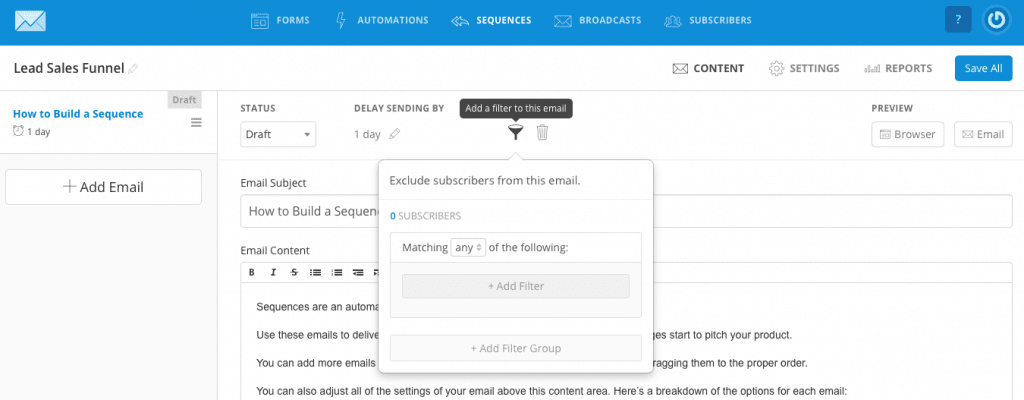
Be sure you also change your sequence to PUBLISHED before adding the form to your website and test signing up so you can be sure everything is working properly.

The REPORTS tab will show you:
- how many people are unconfirmed (if you use double opt-in)
- confirmed
- unsubscribed
- Open rate
- Click rate
Based on the entire sequence (shown on the left) as well as for each email. This will point out any leaks in your funnel; if people stop opening your emails after the second one, you may need to improve your content or subject lines.
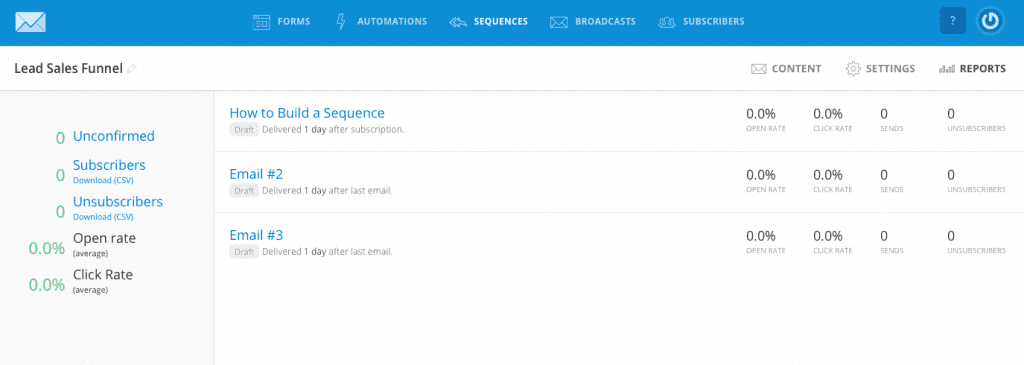
Sequences should:
- Give more than they ask for – give your subscribers more value than you ask them to give you. Don’t push for a sale in every email; your items can be available to click on but save the hard sell for the last email.
- Be high quality – take your time putting your sequences together. If your subscribers don’t find your email topics interesting, they’ll ignore, delete or unsubscribe.
- Build trust – if your emails are low quality, too pushy, too frequent, etc. you won’t strengthen your shoppers’ trust in you or encourage them to buy. Each email should slowly turn up the heat and ease subscribers into the idea of purchasing.
SALES FUNNEL STEP 4 – SET UP AUTOMATIONS
To correctly identify subscribers and know what type of a sequence to send them, you’ll need to tag them. When someone signs up for your newsletter did they purchase or not purchase?
Imagine you just purchased an item and two days later you receive an email from the business asking if you want to purchase again. Seems a little pushy right? You may not have even received your purchase yet, how could you possibly be ready to buy again? A promotional email would be more appropriate to send in a month.
But if you don’t purchase, going a month without hearing from a business would make you less likely to buy. You’ve probably forgotten about the item you were looking at and may have even forgotten the business’ name…who’s emailing me?
Through Convertkit, you can either use different signup forms, which can trigger different sequences and tag subscribers, or you can tag a subscriber as “purchased” or “has not purchased” based on an action.
In order to automatically tag someone as “purchased” you must integrate your ecommerce store with Convertkit under AUTOMATIONS -> INTEGRATIONS
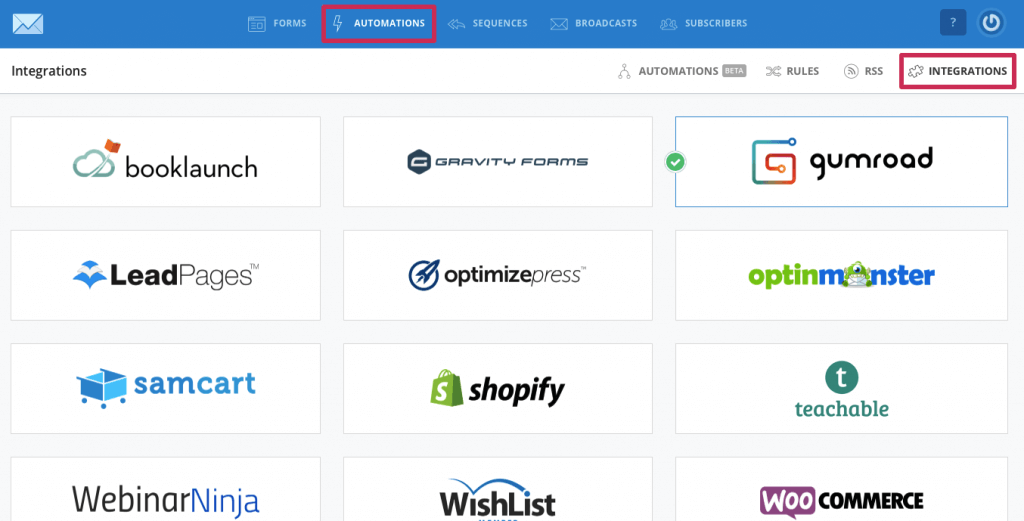
Shopify, Woocommerce and Gumroad are a few tools Convertkit supports. Once they’re linked up, Convertkit will recognize when one of your subscribers purchases and can tag them, un-tag them, subscribe them to a sequence, etc.
There are lots of other helpful options you can set up through automations that will ensure subscribers are receiving the right type of emails at the right time to increase engagement and sales.
HOW TO SET UP A RULE
Select a TRIGGER
In AUTOMATIONS, you can click on RULES. Click “Add a Rule” which will bring up TRIGGERS on the left side of the screen and ACTIONS on the right.

If you used Shopify, Woocommerce or Gumroad to sell your handmade products and have integrated them with Convertkit, you can select PURCHASES A PRODUCT under Triggers.
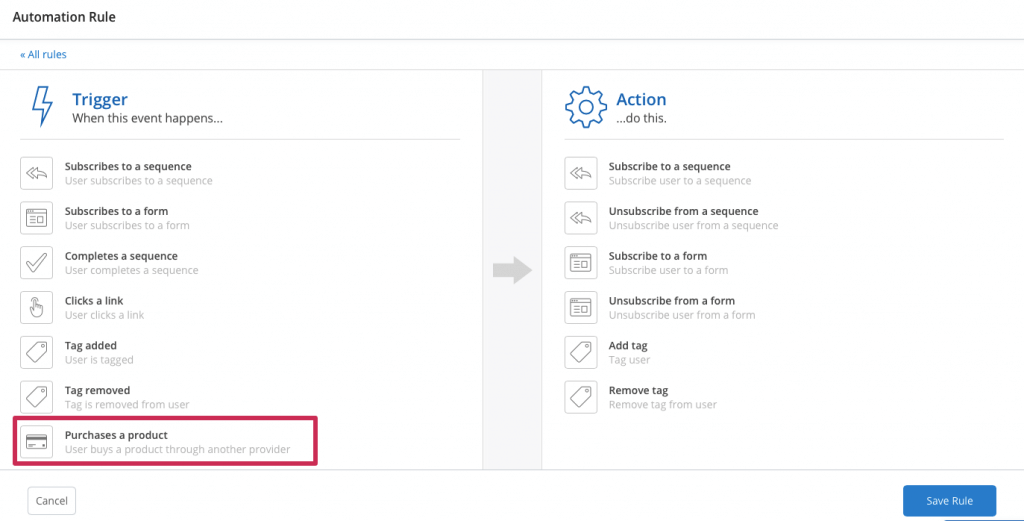
Select a provider and then select a product. To add multiple products, add the + button to repeat the steps.
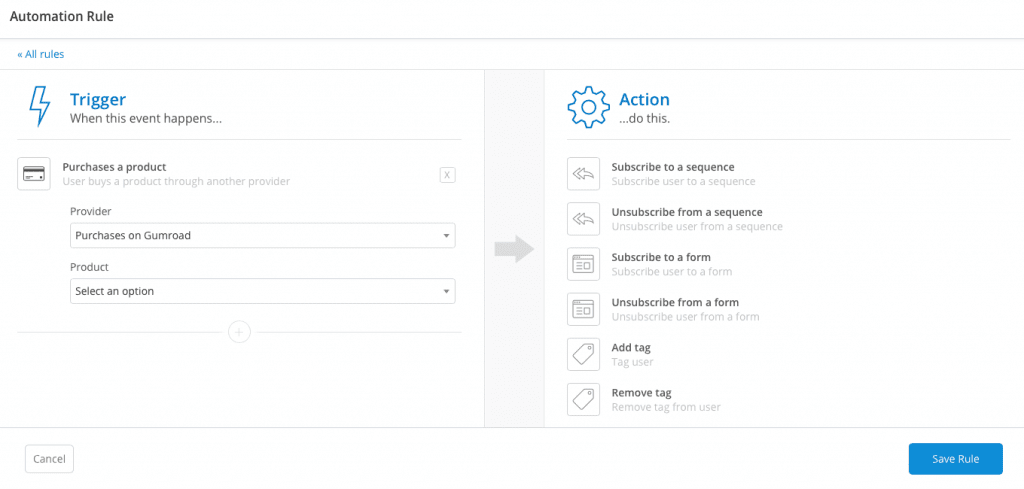
It takes a bit of time to get set up but it’s worth it.
If you don’t use a platform that can be integrated with Convertkit and automatically track purchases, you can create a different form. Only show the form after someone has completed a transaction so you know anyone who subscribes through it must have purchased and can tag them as a “purchased”.
Select an ACTION
When someone becomes a subscriber you can:
- Subscribe them to a sequence – you can set up several sequences and use one to send to people who have purchased and keeps them informed, one to encourage leads to purchase and maybe one to run a holiday promotion.
- Unsubscribe them from a sequence – for example, if someone entered your sales funnel and hadn’t purchased but decided to buy an item halfway through the sales funnel, you may want to unsubscribe the person from your “has no purchased” sales funnel so they don’t continue to receive sales-related emails.
- Subscribes them to a form – add them to any one of the forms you have created.
- Unsubscribes them from a form – remove them from a form they subscribed through.
- Add a tag – you can add the “purchased” tag to that subscriber so you know in your whole newsletter list who has purchased and who hasn’t
- Removes a tag – if a subscriber has the “has not purchased” tag because they signed up for your newsletter without buying anything, you’d want to remove the “not purchased” tag if they purchased at a later date, to properly identify them in your list.
You can choose one action or multiple actions. Use the + button to add additional actions.
For example, when someone purchases, you may:
- Subscribe them to your “purchased” sequence
- Add a “purchased” tag
- Remove the “has not purchased” tag
Save the rule and edit or delete it at any time.
SALES FUNNEL STEP 5 – ASSESS & ADJUST
Your forms, emails, sequences, rules, etc. are not set in stone. Make edits to them as you go based on:
- Bounce rates – a form that’s triggered too soon on a site may be annoying people and getting them to leave.
- Average time on page – this can be a good indication for when to trigger your pop up form. If people tend to leave a page after 30 seconds, setting your pop up to appear on exit or just before the 30-second mark may catch people before they leave.
- Newsletter open rates – low open rates may indicate you’re not attracting your ideal customer to subscribe or that your subject lines need work.
- Newsletter click rates – low click rates may indicate your email content isn’t compelling enough or the subject is misleading subscribers. If you misrepresent what’s inside to get people to open, most won’t click the link or might even unsubscribe. Also, be sure you’re actually providing a link to your website within an email. I’ve seen some people put a full blog article in their email instead of making me click a link and go to their blog. That’s lost website traffic and revenue.
- Newsletter conversion rates – if you have a way to track sales (e.g. through a promo code offered only in the email or a unique sales page only subscribers are sent to) pay attention to how many people who open your newsletter and click the link, actually end up buying. If it’s low, the problem may be your sales channel funnel.
- Unsubscribers – don’t worry too much about people unsubscribing; it’s inevitable. The average unsubscribe rate is 0.49%. If you’re much higher than that, consider if you’re targeting the right people, have the right opt-in offer, are sending valuable content, etc.
If you’d like more information on where to market your products, the methods to use, the sales funnels you should set up, examples and how-to instructions, check out my ebook HOW TO SELL HANDMADE BEYOND FRIENDS & FAMILY.
If you’re interested in joining Convertkit, you can check them out here
Any questions about sales funnels or how to set on up?
*Be sure to check your country’s newsletter laws before setting up forms or sending out newsletters.
This post may contain affiliate links, which means I’ll receive a commission if you purchase through my link, at no extra cost to you. Please read the full disclosure here.

Hey, I’m Erin 🙂 I write about small business and craft show techniques I’ve learned from being a small business owner for almost 2 decades, selling at dozens of craft shows, and earning a diploma in Visual Communication Design. I hope you find my advice helpful!

Absolutely Awesome……
Very easy to understand….
Thanku for this valuable information!!!
This is awesome! It’s self explanatory. I just finished learning how to make handmade beaded products. The eBook “how to sell handmade beyond friends & family” will be of help to me. How will I make payment? I’m in Nigeria and I have not engaged in payment like this before.